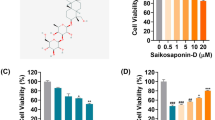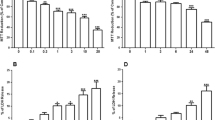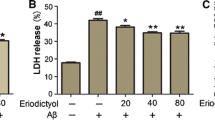Abstract
Previously, we reported that isoflavones exert a protective effect against the endoplasmic reticulum (ER) stress-mediated neuronal degeneration, and ER stress-mediated homocysteine toxicity may play an important role in the pathogenesis of neurodegeneration. Therefore, in this study we investigated the effects of isoflavones (genistein and daidzein) against homocysteine-mediated neurotoxicity in SH-SY5Y human neuroblastoma cells. The treatment of cells with either 17β-estradiol or isoflavones significantly protected the cells against homocysteine-mediated apoptosis. Isoflavones repressed homocysteine-mediated ER stress, reflected in the reduced expression of the immunoglobin heavy chain-binding protein mRNA, spliced X-box-protein-1 mRNA and the phosphorylated form of eukaryotic translation initiation factor 2α protein. Homocysteine caused significant increases in intracellular S-adenosylhomocysteine (SAH) and DNA damage. Isoflavones significantly alleviated DNA damage, but did not change SAH levels. Furthermore, the treatment of cells with isoflavones significantly reduced the microtubule-associated protein tau hyperphosphorylation by inactivating glycogen synthase kinase-3β and activating serine/threonine-protein phosphatase 2A. These results clearly demonstrate that isoflavones alleviate the ER stress- and DNA damage-mediated neurodegeneration caused by homocysteine.








Similar content being viewed by others
References
Alonso ADC, Zaidi T, Novak M, Grundke-Iqbal I, Iqbal K (2001) Hyperphosphorylation induces self-assembly of τ into tangles of paired helical filaments/straight filaments. Proc Natl Acad Sci USA 98:6923–6928
Althausen S, Paschen W (2000) Homocysteine-induced changes in mRNA levels of genes coding for cytoplasmic- and endoplasmic reticulum-resident stress proteins in neuronal cell cultures. Brain Res Mol Brain Res 84:32–40
Bingham S, Atkinson C, Liggins J, Bluck L, Coward A (1998) Phyto-oestrogens: where are we now? Br J Nutr 79:393–406
Blount BC, Mack MM, Wehr CM, MacGregor JT, Hiatt RA, Wang G, Wickramasinghe SN, Everson RB, Ames BN (1997) Folate deficiency causes uracil misincorporation into human DNA and chromosome breakage: implications for cancer and neuronal damage. Proc Natl Acad Sci USA 94:3290–3295
Bottiglieri T (1990) Isocratic high-performance liquid chromatographic analysis of S-adenosylmethionine and S-adenosylhomocysteine in animal tissues: the effect of exposure to nitrous oxide. Biomed Chromatogr 4:239–241
Boyce M, Yuan J (2006) Cellular response to endoplasmic reticulum stress: a matter of life or death. Cell Death Differ 13:363–373
Calfon M, Zeng H, Urano F, Till JH, Hubbard SR, Harding HP, Clark SG, Ron D (2002) IRE1 couples endoplasmic reticulum load to secretory capacity by processing the XBP-1 mRNA. Nature 415:92–96
Cardona-Gomez P, Perez M, Avila J, Garcia-Segura LM, Wandosell F (2004) Estradiol inhibits GSK3 and regulates interaction of estrogen receptors, GSK3, and beta-catenin in the hippocampus. Mol Cell Neurosci 25:363–373
Chiang PK, Gordon RK, Tal J, Zeng GC, Doctor BP, Pardhasaradhi K, McCann PP (1996) S-Adenosylmethionine and methylation. FASEB J 10:471–480
Day JK, Bauer AM, desBordes C, Zhuang Y, Kim B-E, Newton LG, Nehra V, Forsee KM, MacDonald RS, Besch-Williford C, Huang TH-M, Lubahn DB (2002) Genistein alters methylation patterns in mice. J Nutr 132:2419S–2423S
Dolinoy D, Weidman J, Waterland R, Jirtle R (2006) Maternal genistein alters coat color and protects Avy mouse offspring from obesity by modifying the fetal epigenome. Environ Health Perspect 114:567–572
Dolinoy DC, Huang D, Jirtle RL (2007) Maternal nutrient supplementation counteracts bisphenol A-induced DNA hypomethylation in early development. Proc Natl Acad Sci USA 104:13056–13061
Esteller M (2005) Aberrant DNA methylation as a cancer-inducing mechanism. Annu Rev Pharmacol Toxicol 45:629–656
Fuchs D, Erhard P, Rimbach G, Daniel H, Wenzel U (2005) Genistein blocks homocysteine-induced alterations in the proteome of human endothelial cells. Proteomics 5:2808–2818
Fuso A, Cavallaro RA, Zampelli A, D’Anselmi F, Piscopo P, Confaloni A, Scarpa S (2007) γ-Secretase is differentially modulated by alterations of homocysteine cycle in neuroblastoma and glioblastoma cells. J Alzheimers Dis 11:275–290
Goodenough S, Schleusner D, Pietrzik C, Skutella T, Behl C (2005) Glycogen synthase kinase 3beta links neuroprotection by 17beta-estradiol to key Alzheimer processes. Neuroscience 132:581–589
Guerrero-Bosagna C, Sabat P, Valdovinos F, Valladares L, Clark S (2008) Epigenetic and phenotypic changes result from a continuous pre and post natal dietary exposure to phytoestrogens in an experimental population of mice. BMC Physiol 8:17
Henderson VW (1997) Estrogen, cognition, and a woman’s risk of Alzheimer’s disease. Am J Med 103:11S–18S
Ho KP, Li L, Zhao L, Qian ZM (2003) Genistein protects primary cortical neurons from iron-induced lipid peroxidation. Mol Cell Biochem 247:219–222
Hong T, Nakagawa T, Pan W, Kim MY, Lee Kraus W, Ikehara T, Yasui K, Aihara H, Takebe M, Muramatsu M, Ito T (2004) Isoflavones stimulate estrogen receptor-mediated core histone acetylation. Biochem Biophys Res Commun 317:259–264
James SJ, Melnyk S, Pogribna M, Pogribny IP, Caudill MA (2002) Elevation in S-Adenosylhomocysteine and DNA hypomethylation: potential epigenetic mechanism for homocysteine-related pathology. J Nutr 132:2361S–2366S
Katayama T, Imaizumi K, Manabe T, Hitomi J, Kudo T, Tohyama M (2004) Induction of neuronal death by ER stress in Alzheimer’s disease. J Chem Neuroanat 28:67–78
Kaufman R (2002) Orchestrating the unfolded protein response in health and disease. J Clin Invest 110:1389–1398
Kennedy BP, Bottiglieri T, Arning E, Ziegler MG, Hansen LA, Masliah E (2004) Elevated S-adenosylhomocysteine in Alzheimer brain: influence on methyltransferases and cognitive function. J Neural Transm 111:547–567
Kim H, Xia H, Li L, Gewin J (2000) Attenuation of neurodegeneration-relevant modifications of brain proteins by dietary soy. BioFactors 12:243–250
Kim H-J, Cho H-K, Kwon YH (2008) Synergistic induction of ER stress by homocysteine and β-amyloid in SH-SY5Y cells. J Nutr Biochem 19:754–761
Kruman II, Culmsee C, Chan SL, Kruman Y, Guo Z, Penix L, Mattson MP (2000) Homocysteine elicits a DNA damage response in neurons that promotes apoptosis and hypersensitivity to excitotoxicity. J Neurosci 20:6920–6926
Kruman II, Kumaravel TS, Lohani A, Pedersen WA, Cutler RG, Kruman Y, Haughey N, Lee J, Evans M, Mattson MP (2002) Folic acid deficiency and homocysteine impair DNA repair in hippocampal neurons and sensitize them to amyloid toxicity in experimental models of Alzheimer’s disease. J Neurosci 22:1752–1762
Lee Y, Lee H, Sohn H (2005) Soy isoflavones and cognitive function. J Nutr Biochem 16:641–649
Leung H, Yung L, Poon C, Shi G, Lu A, Leung L (2009) Genistein protects against polycyclic aromatic hydrocarbon-induced oxidative DNA damage in non-cancerous breast cells MCF-10A. Br J Nutr 101:257–262
Linford N, Dorsa D (2002) 17β-Estradiol and the phytoestrogen genistein attenuate neuronal apoptosis induced by the endoplasmic reticulum calcium-ATPase inhibitor thapsigargin. Steroids 67:1029–1040
Liu F, Iqbal K, Grundke-Iqbal I, Gong C-X (2002) Involvement of aberrant glycosylation in phosphorylation of tau by cdk5 and GSK-3β. FEBS Lett 530:209–214
Luchsinger J, Mayeux R (2004) Dietary factors and Alzheimer’s disease. Lancet Neurol 3:579–587
Mattson MP (2004) Pathways towards and away from Alzheimer’s disease. Nature 430:631–639
Mattson MP, Chan SL (2001) Dysregulation of cellular calcium homeostasis in Alzheimer’s disease: bad genes and bad habits. J Mol Neurosci 17:205–224
Mattson M, Shea T (2003) Folate and homocysteine metabolism in neural plasticity and neurodegenerative disorders. Trends Neurosci 26:137–146
Obeid R, Herrmann W (2006) Mechanisms of homocysteine neurotoxicity in neurodegenerative diseases with special reference to dementia. FEBS Lett 580:2994–3005
Outinen PA, Sood SK, Liaw PC, Sarge KD, Maeda N, Hirsh J, Ribau J, Podor TJ, Weitz JI, Austin RC (1998) Characterization of the stress-inducing effects of homocysteine. Biochem J 332:213–221
Park Y-J, Jang Y-m, Kwon YH (2009) Isoflavones prevent endoplasmic reticulum stress-mediated neuronal degeneration by inhibiting tau hyperphosphorylaltion in SH-SY5Y cells. J Med Food 12:528–535
Picerno I, Chirico C, Condello S, Visalli G, Ferlazzo N, Gorgone G, Caccamo D, Ientile R (2007) Homocysteine induces DNA damage and alterations in proliferative capacity of T-lymphocytes: a model for immunosenescence? Biogerontology 8:111–119
Raschke M, Rowland IR, Magee PJ, Pool-Zobel BL (2006) Genistein protects prostate cells against hydrogen peroxide-induced DNA damage and induces expression of genes involved in the defence against oxidative stress. Carcinogenesis 27:2322–2330
Scarpa S, Fuso A, D’Anselmi F, Cavallaro RA (2003) Presenilin 1 gene silencing by S-adenosylmethionine: a treatment for Alzheimer disease? FEBS Lett 541:145–148
Sontag E, Nunbhakdi-Craig V, Sontag J-M, Diaz-Arrastia R, Ogris E, Dayal S, Lentz SR, Arning E, Bottiglieri T (2007) Protein phosphatase 2A methyltransferase links homocysteine metabolism with tau and amyloid precursor protein regulation. J Neurosci 27:2751–2759
Vulliet R, Halloran SM, Braun RK, Smith AJ, Lee G (1992) Proline-directed phosphorylation of human Tau protein. J Biol Chem 267:22570–22574
Wang KKW (2000) Calpain and caspase: can you tell the difference? Trends Neurosci 23:20–26
Werstuck GH, Lentz SR, Dayal S, Hossain GS, Sood SK, Shi YY, Zhou J, Maeda N, Krisans SK, Malinow MR, Austin RC (2001) Homocysteine-induced endoplasmic reticulum stress causes dysregulation of the cholesterol and triglyceride biosynthetic pathways. J Clin Invest 107:1263–1273
Xu C, Bailly-Maitre B, Reed JC (2005) Endoplasmic reticulum stress: cell life and death decisions. J Clin Invest 115:2656–2664
Yi P, Melnyk S, Pogribna M, Pogribny IP, Hine RJ, James SJ (2000) Increase in plasma homocysteine associated with parallel increases in plasma S-adenosylhomocysteine and lymphocyte DNA hypomethylation. J Biol Chem 275:29318–29323
Yoon SY, Choi HI, Choi JE, Sul CA, Choi JM, Kim DH (2007) Methotrexate decreases PP2A methylation and increases tau phosphorylation in neuron. Biochem Biophys Res Commun 363:811–816
Zhang Y, Bhavnani B (2006) Glutamate-induced apoptosis in neuronal cells is mediated via caspase-dependent and independent mechanisms involving calpain and caspase-3 proteases as well as apoptosis inducing factor (AIF) and this process is inhibited by equine estrogens. BMC Neurosci 7:49
Zhang C, Cai Y, Adachi MT, Oshiro S, Aso T, Kaufman RJ, Kitajima S (2001) Homocysteine induces programmed cell death in human vascular endothelial cells through activation of the unfolded protein response. J Biol Chem 276:35867–35874
Zhang C-E, Tian Q, Wei W, Peng J-H, Liu G-P, Zhou X-W, Wang Q, Wang D-W, Wang J-Z (2008) Homocysteine induces tau phosphorylation by inactivating protein phosphatase 2A in rat hippocampus. Neurobiol Aging 29:1654–1665
Zhao L, Chen Q, Brinton RD (2002) Neuroprotective and neurotrophic efficacy of phytoestrogens in cultured hippocampal neurons. Exp Biol Med (Maywood) 227:509–519
Acknowledgments
This work was supported by a grant from the Korea Research Foundation (KRF-2006-331-C00311), Korea.
Author information
Authors and Affiliations
Corresponding author
Rights and permissions
About this article
Cite this article
Park, YJ., Jang, Y. & Kwon, Y.H. Protective effect of isoflavones against homocysteine-mediated neuronal degeneration in SH-SY5Y cells. Amino Acids 39, 785–794 (2010). https://doi.org/10.1007/s00726-010-0523-5
Received:
Accepted:
Published:
Issue Date:
DOI: https://doi.org/10.1007/s00726-010-0523-5




